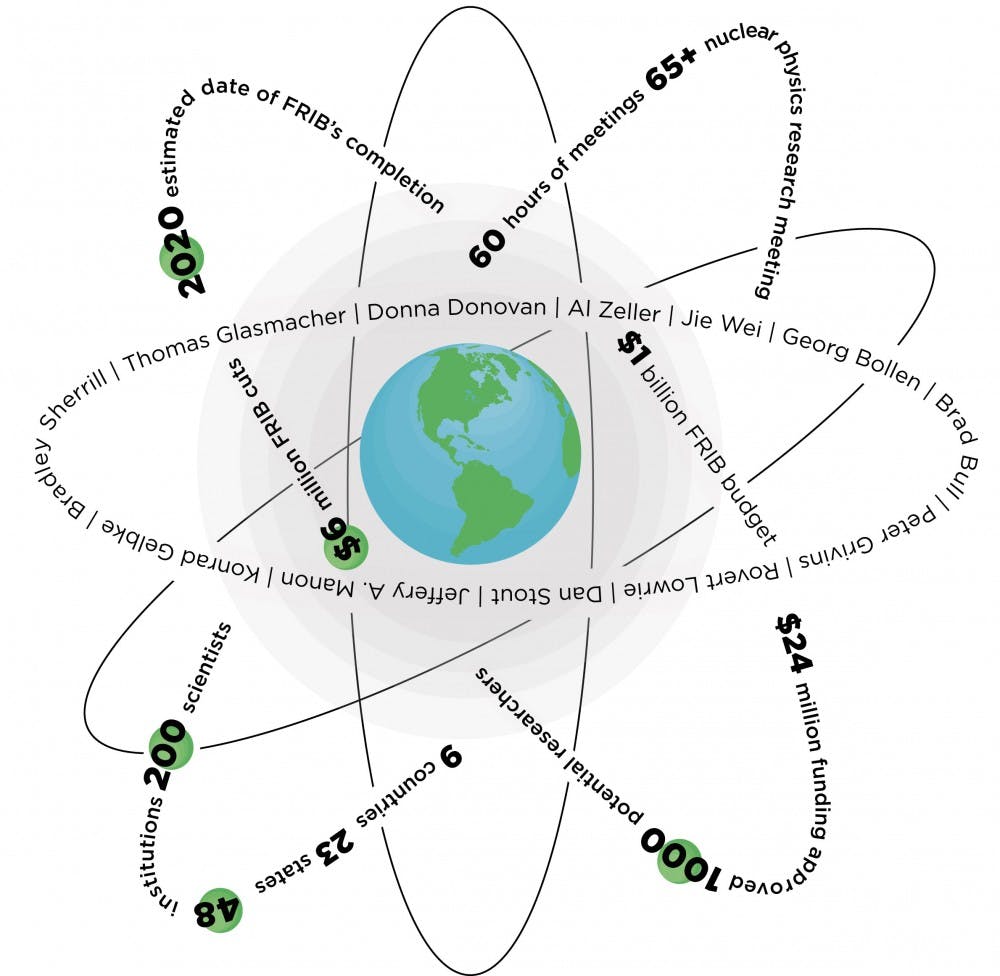Under a growing cloud of concerns surrounding science funding cutbacks by the federal government, more than 200 scientists flocked to MSU on Aug. 18-20 for a conference with implications for the future of nuclear physics work in the U.S.
Scientists from 48 different institutions — including representatives from four major U.S. nuclear research labs, such as MSU’s National Superconducting Cyclotron Laboratory, or NSCL — attended dozens of meetings during a two-and-a-half-day period, hammering out policy details and discussing research initiatives.
All the while, conference attendees looked forward to the future of MSU’s Facility for Rare Isotope Beams, or FRIB, a project with an estimated completion date of 2020 and a budget topping $600 million.
Officials said FRIB and MSU administrators have begun discussions that would allow construction at the site to start as early as next year, putting the project ahead of schedule.
Scientists said the $600 million facility could lead to new discoveries about rare atoms and nuclear physics and bring in upward of 1,000 researchers from across the world. In addition to the project’s federal government funding, FRIB will receive financial support from the state of Michigan and from future indirect cost recoveries derived from the project, said Dave Byelich, MSU’s director in the Office of Planning and Budgets.
Researchers and conference attendees were optimistic about FRIB’s potential, even after a project spending bill filled with $6 million in cuts to the facility was passed by the U.S. House Appropriations Committee earlier this summer.
The U.S. Senate Appropriations Committee approved its own version of FRIB’s fiscal year funding last week, setting aside $24 million for the facility — a figure that keeps the $6 million cut in place.
Despite deep funding cuts, FRIB officials are confident in the conference’s success and its role in supporting future FRIB initiatives.
FRIB’s communications Manager Alex Parsons called the conference “a great success.”
“Meetings between scientists, like the one that took place (in August), provide a great opportunity for collaboration that leads to scientific breakthroughs,” Parsons said in an email. “World-leading science will continue at NSCL and other laboratories for the next several years while FRIB is under construction.”
Visualizing the future
Since MSU was selected in late 2008 by the Department of Energy’s Office of Science as the location to build the facility, beating out Argonne National Laboratory near Chicago, officials have touted FRIB as a creator of jobs and a science industry driver, a place with “unmatched capabilities,” Parsons said.
The conference reaffirmed FRIB’s commitment to many of those policies, he said.
“A vital and engaged user community is essential to the success of FRIB when it becomes operational later this decade,” Parsons said. “The attendance and interest from researchers shows that scientists are excited to use … FRIB.”
Some scientists continue to plug away — with an eye toward FRIB’s completion — at other nuclear physics labs across the country, including the Oak Ridge National Laboratory in Oak Ridge, Tenn. Representatives from Oak Ridge and the Argonne National Laboratory also attended the conference.
“It was a fantastic gathering of the (low energy nuclear physics) research community,” said Michael Smith, a conference attendee and a scientist in Oak Ridge’s physics division, in an email.
MSU physics graduate student and FRIB researcher Kritsada Kittimanapun — who attended multiple sections of the conference — said he believes FRIB will bring numerous opportunities to the university.
“MSU will be an attractive place for scientists to perform their experiments,” he said in an email. “Our facility will be one of the best facilities in the world in the field of nuclear physics.”
Work at other facilities, such as Oak Ridge, could benefit FRIB in the future, said Ken Kingery, the NSCL’s communications manager.
“There’s a lot of research being conducted at these labs to make FRIB a reality,” Kingery said.
Slashing funds
In mid-June, the House Appropriations Committee passed a spending bill allotting $24 million in funding for this fiscal year for MSU’s FRIB, which was upheld in the U.S. Senate last week.
Given cutbacks to other key science projects across the country, MSU officials remain optimistic about project funding.
Support student media!
Please consider donating to The State News and help fund the future of journalism.
“We appreciate that the Senate Appropriations Committee has approved continued funding for (FRIB),” university spokesman Kent Cassella said. “Obviously, we are concerned that the Congress was unable to provide full funding for a number of … programs, including FRIB, but we recognize that these are very difficult financial times.”
Cassella said federal officials’ financial commitment to the project shows FRIB remains a “national priority.”
U.S Rep. Mike Rogers, R-Brighton, who has been a vocal advocate for the project, also said he was pleased by federal government funding efforts.
“I continue to be proud of MSU’s many years of work to make FRIB a centerpiece of America’s research profile,” Rogers said in a statement.
Eye on the prize
FRIB chief scientist Brad Sherrill said productive conversations between the university and the FRIB could propel the project more quickly toward its final goal.
“FRIB and MSU have an idea for how to advance specifically,” Sherrill said. “The hope would be that that would make it easier to finish the project on schedule.”
Sherrill said those plans still are subject to review by the Department of Energy. That decision will come down in March or April of next year, he said.
In the meantime, MSU researchers and officials continue to look to the future, encouraged by the conference’s success and the potential for new research.
“I think it was a very healthy sign that so many people were interested and came here,” Sherrill said. “There are a lot of interesting ideas that people have — this is what we’re hoping is possible.”
To take a quiz on the Facility for Rare Isotope Beams, click here.
Discussion
Share and discuss “Right on track” on social media.





